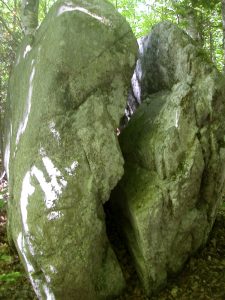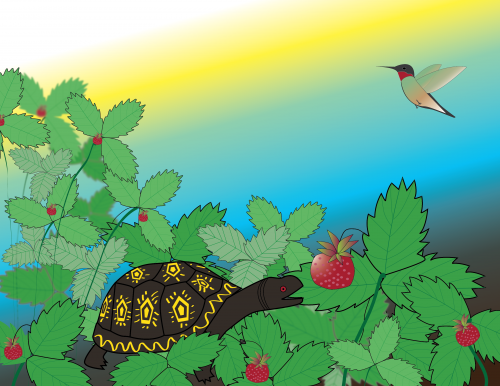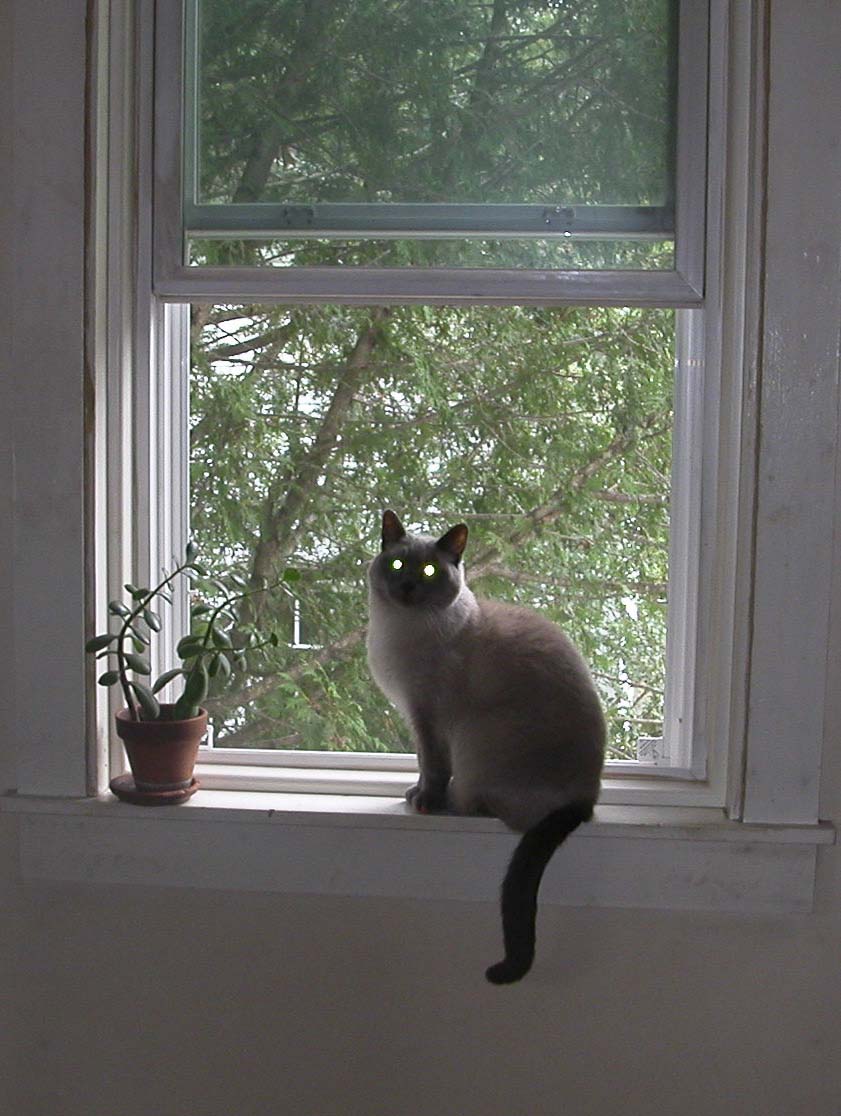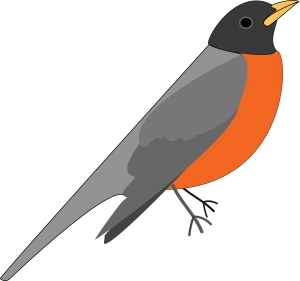
Category: Animals
A Great Bear
March 26, 2021For a class this week, I’m translating a story about Yellow Yellow, a Black Bear who was famous in the Adirondacks for breaking into bear cannisters. For some reason, she was tagged twice and got her name from the two tags. While most bears drop the cannisters over a cliff, hoping to break the cannister, Yellow Yellow actually figured out how to open the lid. She foiled a few generations of cannisters, driving hungry backpackers crazy, before she was killed in season by a hunter.
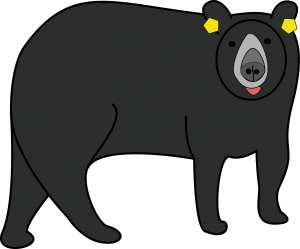
Sharing Community Stories
February 26, 2021
Over the past few years, a community in the Adirondacks has been coming together to record local history through stories. Under the brilliant organization of Jeri Huntley, with the support of the Keene Valley Library, My Adirondack Story is a website where the meaningful stories of ordinary people who live in the Adirondacks are told in their own voices. The stories are about five minutes long, and together they give a mosaic of life here. For people who come to the Adirondacks for a few days of recreation during the summer, it can provide a fuller picture of place.
Now there is a resource guide for others to create a project like My Adirondack Story in their communities. Our Story Bridge is a great way to connect and preserve history. There is also a teacher’s guide for helping schools create a similar project. The guide is designed for middle and high schools, but many colleges in New York State are already using these materials.
Yours truly shares an Adirondack story for the project here.
Moon Con 21
February 19, 2021Mark your calendar! Moon Books will be sponsoring a conference featuring its Pagan authors June 5-6. The conference, live on Facebook, will feature talks, panels, and Q&A sessions. It will be free!

Yours truly will be speaking at the online conference on Sunday, June 6th at 10:00 a.m. Eastern Daylight Time. Below is a description of the talk, which is open to everyone.
Staring Back at the Deer
The deer is an emissary from the world of fey, a shapeshifter who watches from a distant place and brings messages which touch our spirit. This session will examine the deer from a material and cultural point of view, with the aim of interpreting deer signs and courting the deer to enhance our magic.
Hearth Moon Rising pursues an animistic practice of Witchcraft in the Adirondack Mountains. She is the author of Invoking Animal Magic: A guide for the pagan priestess and Divining with Animal Guides: Answers from the world at hand. She is ordained in the Dianic Tradition and the Fellowship of Isis.
Getting ready for 2021
November 27, 2020Terror of the Forest
November 6, 2020The return of large tracts of mature forest in the eastern United States has meant the resurgence of two fierce creatures: the Fisher and Northern Goshawk. I wrote about the Fisher here. I have had the distinction of having been seriously threatened by both animals, although neither made contact.
I wrote about my encounter with the Goshawk for Moon Books Blog back in 2018, but the pictures got messed up when they changed the website. Here is another one.
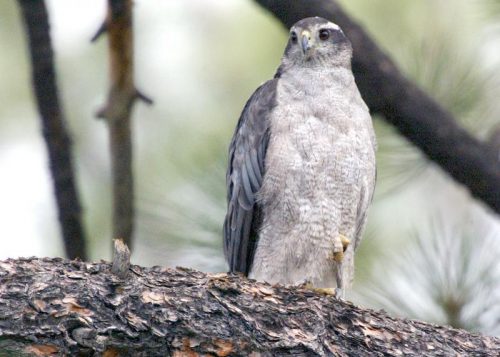
To be fair, I’ve had plenty of encounters with Goshawks and Fishers where I did not feel threatened. Fishers, especially, have snarled at me from their perches in the lower branches of trees, but I stepped away to relieve their distress, not because I was in danger.
The Goshawk is a favorite falconry bird, because she is large and agile. Whenever I encounter a hawk or falcon in meditation, I feel an overpowering urge to take up falconry. Then I come out of my trance and realize I don’t have what it takes to commit to a feathered familiar. They require a great deal of time and attention, and most raptors are long-lived. So I continue cultivating my relationship on a metaphysical plane.
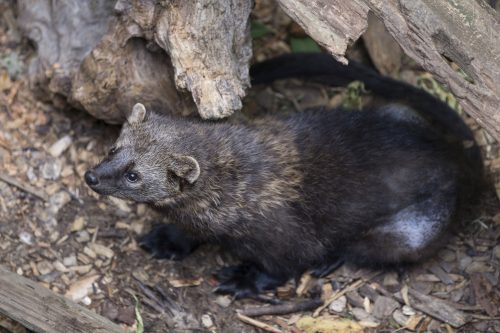
When I hear that ki-ki-ki-ki-ki-ki-ki-ki in the forest, however, I respectfully back away. That encounter with the Goshawk was the most frightening experience I have had, worse even than meeting that Mountain Lion that refused to back off. I have a theory that an aggressive encounter with an animal can transfer power, even if it feels uncomfortable at the time. Certainly there are some encounters that change a person forever.
House of the Belted Kingfisher
October 23, 2020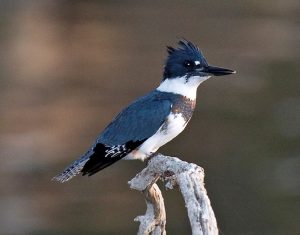
The Belted Kingfisher appeared in a recent journey-meditation to tell me…what exactly?
This colorful bird will be leaving my locale soon as ponds and lakes freeze over, though in much of the United States the Kingfisher overwinters. Various types of kingfishers live around the world, wherever there is open water, with the most colorful species in the tropics (of course).
Even in northern latitudes, kingfishers are relatively bright. The Belted Kingfisher is a lovely rich blue. This is a high profile bird, soring over ponds and divebombing for small fish. Sometimes she skims the water, her blue coloring blending in. The female in my area is blue to blue-gray, like the male, but with a rusty “belt” on her breast.
Kingfishers nest in mud burrows along the banks of rivers and ponds, tunneling on an upward slope three to six feet to lay their eggs. They form new nesting pairs every year. Males court females by bringing them fish.
The sound of a Belted Kingfisher is an unmistakable series of rattles that each last a full second or more. She makes this noise flying or when perched looking for prey. She is quite territorial and aggressive toward intruders.
I associate the Belted Kingfisher with the astrological Eighth House, that time of day when the afternoon sun has commenced a noticeable decline in the west. The Eighth House rules death, psychic activity, the occult, and other things that are hidden. Think of the Kingfisher diving into the still water for her meal. Think of the Kingfisher laying her eggs not in the trees or on the ground but in a cavity beneath the soft earth.
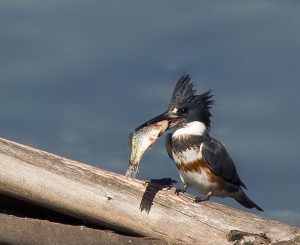
Proud Emblem of the City
October 9, 2020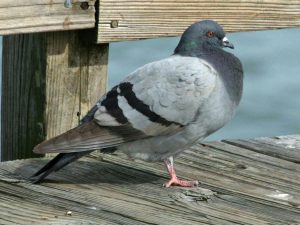
An encounter with a pigeon could have great import, because pigeons are guardians of civilization.
Pigeons are intellectual birds, associated with education, government, and religious institutions. They roost in libraries, government buildings, university buildings, and large places of worship. Wherever there are cities, there are pigeons.
Because pigeons and other doves roosted in the first temples, pigeons became associated with the goddess. Mesopotamians believed these birds came to the temples to carry prayers to the sky deities.
The white pigeon, especially, is a messenger of the goddess. Aphrodite, Ishtar, and Astarte are sometimes pictured with the white dove, which is a pigeon.
The pigeon is the ultimate pro-social bird of complex society. Interestingly enough, while the Mourning Dove and White-winged Dove thrive in open spaces throughout North America, the Rock Pigeon (that introduced species most people are referring to as the “pigeon”) doesn’t survive outside of cities due to predators. Even in the city, Peregrine Falcons and Red-tail Hawks feed on pigeons.
Pigeon numbers are decreasing, although they are not at all endangered. Is this decline caused by an increase in urban raptors or is it a reflection of the anti-intellectual times we live in? Many people claim to hate pigeons, but pigeons are connoisseurs of human institutions and culture. The urban dweller and the pigeon have much in common.
Scramble to Nowhere, Special
June 19, 2020I meant to get this written yesterday, but repairmen scheduled to come Friday showed up Thursday instead. Can’t complain. As things stand during the pandemic, you’re lucky to get someone to come to your house at all.
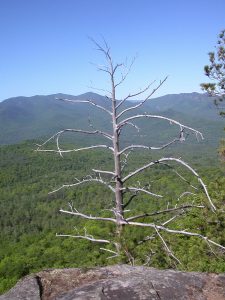
This week I hiked two lesser mountains called The Crows (Big and Little) and an extended ridge line called the Nun-Da-Ga-O Ridge, all on the same day. Nun-Da-Ga-O sounds like it could be an Iroquois word, or Anglicization thereof, but it’s just a name a local hiker made up.
I’ve hiked pieces of this trail, a few miles outside of Keene, New York, many times, but Wednesday I decided to start on Hurricane Road, summit Little Crow, traverse the coll to Big Crow, and descend a quarter mile to the Ridge Trail, which undulates up and down for several miles in numerous rock scrambles before descending at Weston Mountain to Lost Pond. From there, it’s flat easy trail to Crow Clearing, a parking lot where most people hike to Big Crow or Lost Pond, or hike the Nun-Da-Ga-O loop, bypassing the Crows.
Little Crow isn’t hiked much. There’s no parking lot, the signage is obscure, and Big Crow is a bigger mountain with an easier ascent. I chose a clockwise loop to get Little Crow out of the way early, since it can be difficult for the vertically challenged (a.k.a., short). I carried a heavy day pack , since I knew there would be no water until I got to the Pond, and the Ridge trail is unmarked, so I needed extra gear and clothing in case I lost the trail and spent the whole day wandering around up there.
I find climbing a treacherous trail with a heavy pack disconcerting. Some people find it harder going down, but I think it’s much easier to jump down than scramble up. I only needed to take off the pack to get over one ledge, as it turns out. I’ve climbed Little Crow many times, but this was the first time the trail was dry. I realized that what I interpreted as a difficult hike was mainly my reluctance to get my knees muddy and my bottom wet. Still, I cursed the giants who cut this trail.
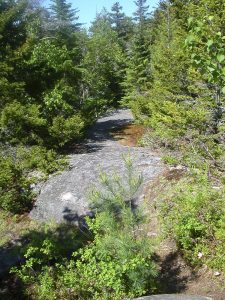
I enjoy Little Crow more for the grass, Red Pine, and lichen near the summit than the views. In the twenty years since I moved to the Adirondacks, many of the views I once enjoyed have partially filled in, as the forests continue to recover from the poor forestry and deliberate fire setting of the nineteenth century. At the summit the scent of balsam pine was pungent. The thing that struck me most when I moved to the Adirondacks from Tucson was the many fragrances, not just of balsam but of sweet fern and wet leaves. The desert only smells like dust, except after a rain, and it doesn’t rain often. In the Adirondacks, it rains a lot. I’ve been up on this range in the rain, in the fog, in many feet of snow, in approaching thunder, and on days when the black flies swarmed so heavy that you had to thread your sandwich under your head net. Usually, though, I pick a better day to be up here. On this day, the deep deep blue of the sky conveyed a limitless calm.
There’s long stretches of scrubby Red Oak on The Crows, not seen much in this area. On the descent into the coll, a Hermit Thrush sang buoyantly. Thrushes kept me company throughout the day.
There was one small section of rock on the descent that looked impossibly steep. I could easily have gone around it, but I calculated that the fall would be minor and there was a tree to grab if I slipped, so I went for it.
Success! It’s always gratifying to find a reasonable place to test the tread on your boots. I would need that security traversing the bare rock up to Big Crow.
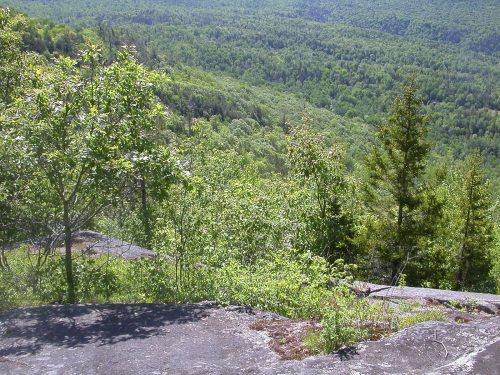
The views on Big Crow are impressive. You can see the Dix Range and the Great Range of the High Peaks. You can also see the weather coming in for quite a ways on this isolated and exposed peak. I was up here once with a very spiritual woman who was praying and praying and praying as the thunder clouds rolled in. Can she hear that or is she deaf, I wondered, cognizant of the quarter hour scramble, at least, to get down into the canopy. When she finally opened her eyes, she said that of course she heard the thunderstorm coming, but she wasn’t finished with her prayer. That’s one tarry at the summit I’ll never forget.
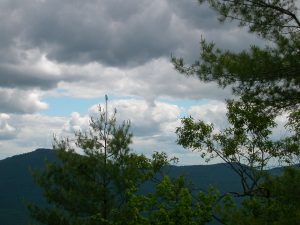
The wider loop I chose was about nine miles and some change, but mileage and net elevation gain doesn’t tell the story of an Adirondack hike. I hiked the same distance, on the Tongue Range over Lake George, two days earlier. That hike took four hours, including stops. This one took seven-and-a-half hours. Nun-Da-Ga-O is a continual up-and-down into depressions of hemlock, beech, and Yellow Birch, then along shallow brush and balsam, with exciting stretches of bare rock and exhilarating climbs. Though this is not an official trail, someone has been maintaining it, sawing through the downed Paper Birch trees that are yielding to maturing forest.

At one point I left the main trail and hobbled up a spur path to a wide cliff ledge for a rest. I’m a steady plodder, not a race-and-rester, on the trail. Even at a summit, I only stop long enough to rehydrate, snap a few pictures, and refresh bug spray. Partly it’s because I’m out for the journey, not the destination. I’m not much of a peak bagger. Also, I usually gauge my abilities against the trail accurately, and I don’t need to rest. There are people, almost invariably young men, who try to race to the summit and brag about their “time,” and I don’t know how to express the derision I feel for this approach to wilderness. Nun-Da-Ga-O is not a scary-steep enterprise, but there is a long way to fall in places if you trip while you’re rushing to “beat your time.”
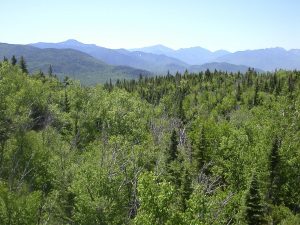
The main reason I spend less time drinking in the view is probably because I live here. Not that I’m inured to the beauty–how can you be? But I’m not indulging in a few days or a few weeks away from it all. My life is here. I have chores before I leave in the morning and my own dinner to cook when I return, possibly with a few have-to’s yet in the day. The next day will probably involve errands or work, even if it’s only writing a blog post, so I’ll need to get to bed early. When you live here, you fit your hiking into your life. I often wonder what it would be like to be on vacation in the Adirondacks; I started a new job the day after I arrived here. Not that I’m complaining. I know I’m incredibly lucky. I also know that when you move to an idyllic spot, you take your life with you.
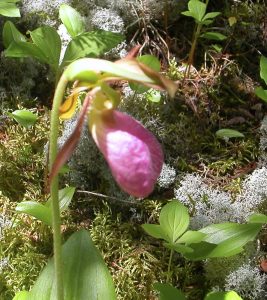
Stepping onto that ledge off the unofficial trail, I stepped between worlds. I reapplied bug repellent, poured some electrolyte replacement powder into my water, snapped some pictures, then just sat. I studied the peaks in the distance and named them. I listened to a Winter Wren singing exuberantly on and on and on. I entered a feeling of aloneness that’s difficult to describe because I don’t understand it myself. I know how to avoid crowds in the Adirondacks and I’m often alone on the trails, sometimes for a full day. I don’t think twice about it. I wasn’t totally alone on this hike. I believe I saw a total of seven people. I don’t like meeting people now that we have COVID-19, but prior to the pandemic I smiled and greeted a fellow traveler as a kindred spirit. With the exception of those beating their time, I like other hikers.
But in that place I felt isolated and alone, in a way that connected me to the rocks and the leafy forest below me, to the blue sky and the Winter Wren singing his complex joyful song. I haven’t felt that far away from other people and their bullshit for a long time. It was like a big bag of other people’s stuff dropped off my shoulders, over the cliff. I felt no pressure, no reason even, to move. I had miles yet to walk, but I knew the trail had no unfair demands to make of me. I don’t even remember if I prayed; the space itself was like a prayer, the heart singing gratitude without reflection.
Hiking is not really about geographical space. It’s about a meeting of trees, rocks, animals, and human. Also sky and wind. It’s different every time, and the difference itself is a gift. I’ve hiked Nun-Da-Ga-O as a bug-bitten endurance event. I’ve been disoriented up there, wandering around and around trying to find the cairn. I’m not trying to convince anyone to hike The Crows or Lost Pond or the ridge between, necessarily. It’s not about where you go, it’s where you are when you get there.

I hit the trail again when I felt myself becoming sleepy. The day was far from over, and there were challenges still ahead. An even bigger cliff loomed ahead of me further on, and I hoped the path would lead up there. It did! There was a rocky scramble to view of Lost Pond below. Above, a pair of Golden Eagles circled.
Golden Eagles are rare in the Adirondacks. They like the high cliffs and open spaces that are more common out West. I’ve been on hikes where others pointed to Golden Eagles in the distance, too far for me to distinguish from any other large bird, but this was the first time a pair circled close enough for me to identify. This time, I remembered to pray.
By the time I got to the last view, Weston Mountain, I was ready to go home, and I even wondered if I was walking in circles, as every rocky outcrop was beginning to look the same. I actually got out my topographical map, a thing I mostly seem to carry around for luck. The Pond was directly below me, so I was on the right path. I was sure of it as I descended Weston, which was the unrelentingly steep sonofabitch I remembered. Yes, I can pray to a mountain and call it a sonofabitch on the same hike. Those who have done a grueling all-day traverse can understand.
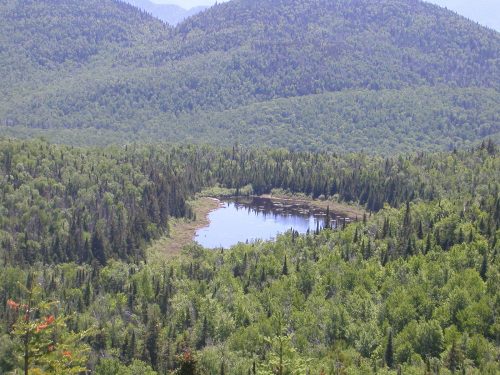
I did not stop at Lost Pond, as planned, because a trio of juvenile ravens had already claimed the space. Raven fledglings scream incredibly loud, and you would think something bizarre and terrible was going on if you didn’t know better. They like to hear their own voices. Some people mistake these cries, which can go on for hours, for a person screaming. Fortunately I knew what was going on, so I didn’t panic, but I took the jarring noise as a sign that it was time to make my way home. I still had three miles to go, on the flat. The beautiful, haunting notes of the Wood Thrush punctuated the late afternoon, as I headed for the car.
